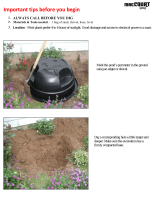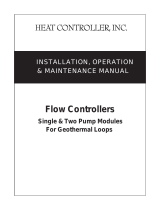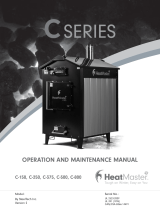Page is loading ...

MAKING MODERN LIVING POSSIBLE
DANFOSS HEAT PUMPS
Installation Guide
Heat Collector

2
Your ground loop system has been designed
to meet the energy requirements of your home
and should not be modied. The ground loop
consists of one or more continuous lengths
of polyethylene pipe laid at in the trenches.
Precisely how you lay your loop depends on
the land you have available and the digging
equipment you will be using. For optimum
eciency, your trench should be dug to a
depth of a minimum of 1m. If the ow and
returns are in the same trench the ground loop
pipes should be horizontally separated by at
least 1m. Neighbouring trenches should be
separated by at least 1 m.
The minimum bending diameter [please refer
to the manufacturers specications] must be
exceeded, anything less than this and the
pipe will be damaged. A narrow single pipe
trench can be dug as long as a m separation
is maintained.
In the case of a multi-loop system, you must
ensure that your trenching begins and termi-
nates at the same point, i.e. at the location of
the man-hole chamber.
All holes through walls where pipes pass
through should be sealed after installation.
Choose a suitable position in your house, utili-
ty room or integral garage for your heat pump.
The position should be chosen so that the
excavation work for the ground loop outside is
as close to the heat pump as is practicable.
The ground loop constitutes a hydraulic circuit
just like your internal heat distribution circuit.
Any air caught in the loop during operation
will collect at the highest point in the circuit.
Ensure that the loops are installed on ground
that is sloping away from the house or if the land
is at that a fall is created within the trenches.
If this is not possible air bleed points must be
installed at the highest points in the loops.
In planning the layout of the ground loop take
care to avoid any services such as water mains
or foul drains. Should this be unavoidable and
the ground loops come within 1 m of any such
services then the ground loops and/or the
services should be insulated.
Avoid laying the ground loop closer than
1 m from the footings of the house and any
retaining walls. This of course excludes
the nal insulated part of the loop.
Installation Guide Heat Collector
VIBMA102
Please read the whole of this guide carefully before starting the job as there are materials and
equipment that you will need to complete the work successfully.
A pressure test pump capable of
achieving 10 bar pressure.
Compatible connections to connect
the pressure test pump to the
polyethylene pipe.
Pipe end caps.
Pipe end stieners.
A water butt.
Equipment
that you will need
Pre installation
considerations
Planning
the ground work
System with a horizontal
ground loop
It is not advisable to use any mechanical joints
on any buried ground heat exchanger loops.
If your system uses multiple ground heat
exchanger loops you will need a manifold to
connect the loops together. If this cannot be
accommodated next to the heat pump we
recommend that this is sited in a man-hole
chamber so that the mechanical joints can
be inspected at any time. The ow and return
headers from the manifold to the heat pump
should be sized according to the ground
loop and heat pump model. To ensure proper
operation of the system it is essential that
the header pipe diameter has been specied
according to the system pressure drop. If in
doubt please seek advice.
Bleed point construction.
Manual air bleed
Paving stone cover
Cylindrical Sleeve
(Ø 300 mm)
Ø 22 mm pipe
Couplings

3
Typical single ground loop layout.Example of multi-loop system layout.
Installation Guide Heat Collector
VIBMA102
Pressure testing
the ground loop
Installing the
ground loop
When you are ready to lay your ground loop
carefully roll it out from its coil. It is advisable
to do this before your trenching is started
to allow the pipe to relax. Please ensure that
the pipe does not get kinked as this will need
either repairing or replacing.
If there is a large stone or rock at certain points
along the bottom of your trench a shallower
depth or a reduced horizontal separation can
be accepted for a short length. Dependant
on the make up of the ground it is advisable
to lay sand in the bottom of the trench to
help protect the pipe and give good thermal
contact for the ground loop. A further 100 mm
of sand should be laid over the pipe after the
pressure test has been carried out.
Lay your ground loop in the trenches and take
the ends of the loops into your house leaving
1.5 m exposed above oor level. This is a good
time to place your insulation over the pipe
ends. Cap o or tape up the ends of the open
pipes to prevent debris ingress.
Power is required on site to pressure test the
ground loop. You must pressure test the loops
before back lling the trench.
Fit a pipe stiener into both ends of
the loop.
Fill the loop with clean water. You should
let the water run through the loop for at
least 10 minutes after it rst emerges
from the end of the pipe. This will allow
any trapped air and debris to be purged
from the loop.
Fill the pressure test pump with water
and connect to the loop ensuring a good
air tight seal.
Pump water through the loop until you
get a small ow out of the open end of
the loop.
Fit an end cap to the open end of the
loop. Secure tightly.
The test pressure must be 1.5 times the
operating pressure. Take care to follow the
instructions supplied with the pressure
If a duct is being laid prior to the ground loop
being installed this must be of the type that
has a long radius bend to accommodate the
minimum bending diameter of the pipe. Alter-
natively loop tails can be brought in through a
common hole. All inlet methods should allow
for the insulation in addition to the pipe dia-
meter. After the loop system has had its nal
pressure test carried out use a suitable sealant
to close any gaps.
The initial pipe run from the heat pump down
to the bottom of the trench must be insulated
for at least 1m from the building to avoid frost
damage. The insulation used should have a
wall thickness of at least 13 mm.
Passage of pipes through exterior wall.
Exterior wall
Seal
Foundations
Sleeve
Wall cavity
HDPE/MDPE
header pipe
Insulation for
1 m either side

Danfoss Heat Pumps UK
3 Parkwood Business Park
Parkwood Business Park
Sheeld
S3 8AL
Phone: 0114 270 3900
Fax: 0114 275 1398
Email: info[email protected]
www.uk.heatpumps.danfoss.com
Danfoss assumes no responsibility for any errors found in the catalogues, brochures and any other printed material. Danfoss retains the right to make changes to their products, including products that have already
been ordered, without prior notice, as long as these changes can be carried out without changing predetermined specications. All trademarks in this material belong to respective companies. Danfoss and the
Danfoss logo are trademarks that belong to Danfoss A/S. All rights reserved. June 2009
A single ow and return, insulated, pressure
tested and capped o at the position of the
heat pump is required before installation can
take place. All ground loops connecting to
the manifold must be of equivalent length to
ensure equal ow rates.
The chamber should be sized according to
the number of ground loops feeding into it.
Plan the exact position of the manifold and
man-hole chamber carefully to avoid the need
to bend the connecting pipes sharply. All pipe
work above ground and that less than 1m
below should be insulated as previously speci-
ed. The ow and return from the manifold
to the heat pump must be pressure tested for
integrity as per the ground loops.
tester. If there is still some air trapped in
the loop this might take some time to
bleed out.
Record start pressure.
Visually inspect the loop for leaks.
When the pressure falls, the loops are
to be pumped up to the test pressure
again. This is to be repeated until the test
pressure is constant.
Record the pressures at 5 minute inter-
vals. After 20 minutes, check whether the
pressure has fallen. If the pressure has fallen,
the leak must be repaired, after which it is to
be again pumped up to the rest pressure.
Repeat the above until the pressure is
constant at 1.5 times the operating pressure
20 minutes from the last pumping.
After completion of the pressure test remove
the ttings but do not try to retrieve the pipe
stieners. Repeat for each loop.
Lake water heat pumps extract the solar energy
stored in lake water through a collector loop
that is lowered to the bottom of the lake. The
hose is laid on the bottom of the lake or water-
course, with weights holding it securely in
place. The principles of loop spacing, pressure
testing, header pipe and manifold installation
are the same as for ground loops. Man-hole
chambers should be installed at a suitable
point above the water table.
Systems using
pond or lake loops
Manholes chambers for
ground loop manifolds
Installation Guide Heat Collector
VIBMA102
Back lling.
1 m
Sand back ll
Backll hand
compacted
Backll
mechanically
compacted
0.3 m
0.1 m
0.1 m
Note:
When digging and working in trenches
local health and safety regulations must
be applied.
As a rule trench walls should be supported
as the work progresses and this is a manda-
tory requirement for all excavations greater
than 1.2 m deep.
If in doubt please seek specic local guid-
ance appertaining to trenching, excavations
and earthworks.
After a successful pressure test you can now
backll the trenches taking care to ll
around the loops with sand as recom-
mended. Loops should be capped after
testing to prevent dirt getting into the
system.
/



